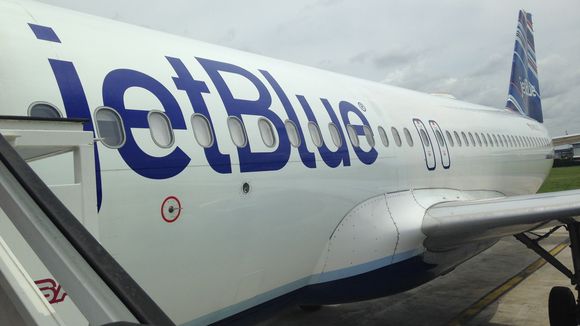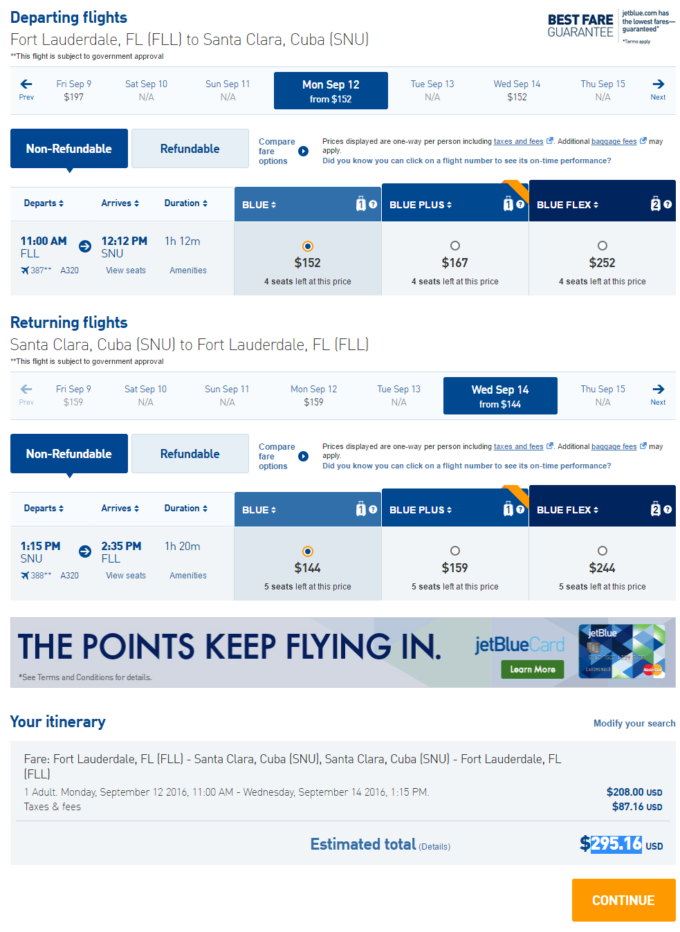
The end of the charters?
HAVANA — On Aug. 31, JetBlue passenger planes will fly from Fort Lauderdale, Fla., to Santa Clara in central Cuba, symbolically cutting the ribbon that re-starts the scheduled flights between the U.S. and Cuba, interrupted in 1961.
This will be the first of about 110 flights (90 to the provinces and 20 to Havana) approved by the U.S. authorities.
But the route to Havana, coveted by practically all the regular airlines, remains frozen. The reason, according to sources in the United States and confirmed by the island authorities, was the lack of approval by U.S. entities.
Our sources tell us that the current demand for flights to Havana made by some airlines exceeds the figures initially agreed upon, and that’s the likely reason for the delay.
Luckily, in the face of so many questions, the Ministry of Transportation held a press conference on Aug. 29 to which the accredited foreign media were invited. A similar press conference was held on Aug. 25, to which only the national media were summoned.
The panelists from the Cuban transport institutions were practically the same. The only difference was that today they granted only three questions and a fourth one at the end of the session.
Progreso Semanal raised three questions, one of which dealt with the topic of reciprocity. The habitual regulations in international flight agreements establish reciprocity — but how will it be carried out in this case?
The question was posed by a colleague, and Alfredo Cordero Puig, president of the Cuban Institute of Civil Aeronautics (IACC), answered that the memorandum of understanding allows for Cubana de Aviación to make the flights and that Cubana is already requesting them.
Left in the air (since we’re talking about flights) was whether Cubana would utilize airplanes from our domestic lines or lease foreign aircraft.
This is not a naive question because Cuba runs the risk that their planes will be seized in the U.S. to pay for the lawsuits of people who argue that they were seriously affected by the Cuban government and demand economic compensation. Cases like that have occurred and the U.S. courts have always ruled for the plaintiff.
It is not enough for the Executive Branch in Washington to guarantee that Cuban aircraft will not be detained and/or confiscated. The judiciary power can act and make determinations.
We also asked Mayda Molina, the IACC’s director of Air Transport and International Relations, why the scheduled airlines were not granted the same facilities in rates and prices as the charter flights.
She answered that both are treated differently worldwide.
“Scheduled airlines allow for longstanding contracts and therefore the prices are different. In the case of the charter flights, they’re paid by a tour operator and it is a rate that the airline booker gives the tour operator so that he may commercialize it,” she said, referring to the prices of tickets in general, not to the rates established by the Cuban authorities.
The ticket prices announced by the commercial airlines that will fly to the provinces can be understood right now as part of a promotional strategy, a search for good positioning in the new market.
Nevertheless, these rates must be approved by the International Air Transport Association (IATA), whose functions include “creating regulatory and facilitating standards for international air traffic, guaranteeing and avoiding unfair competition among the member companies.” Cuba founded IATA in 1945.
In the case of JetBlue, also a member of IATA and the first airline to fly direct to Santa Clara from Fort Lauderdale, the $210 it has announced as the price of its tickets has been approved by IATA. However, the figures listed on its official website are slightly higher.

Those figures normally include payment for the airport services provided by Cuba, collected by the island’s authorities from both the major airlines and the charter airlines. But the big difference in the prices of tickets now being promoted (JetBlue: $210 each) compared with those sold in the past 37 years through charter airlines (more than $400 each) reveal that the rates for these airport services have been different for scheduled and charter flights.
As of this moment, the charter airlines have to pay Cuba about $219 per passenger, more than the cost of a ticket issued by JetBlue.
Now then, after the first stage, once the market stabilizes and the promotional and special-offers period eases, will the charter airlines be charged figures closer to the ones paid by the commercial airlines?
Aviation worldwide is a very technical topic, subject to strict international standards in terms of rates, security systems, government approval, etc. Anything other than a plane flying on time, with all seats occupied, loses money.
While the charters have been for Cuba the equivalent of small “cuentapropistas” [independent entrepreneurs], the major airlines offer the travelers greater safety in case of failure and the structure — built over many years — of one of the world’s most powerful industries.
And that’s good, especially for the travelers, for the hundreds of families and friends on both sides of the Florida Straits.
But, why not let the market decide how the game will be played?
Until a few days ago, we thought that the trend would be the logical competition between the big companies and the charters. But apparently fair play will be nonexistent.
Why?
According to the newspaper Granma, “the Cuban officials pointed out that the prices of tickets are set by the companies, according to the market conditions. However, they also pointed out that the cost of tickets in general should be lower for the charters because that modality provides more stability in the service and receives better conditions in airports worldwide.”
This is normal, in line with the way the market functions, but in the case of Cuba and the charter airlines other factors kick in.
This is one of them. From the beginning, the prices for the charters were established by the Cuban authorities (specifically Havanatur) who, for more than 35 years, have received about $148 for each passenger. This amount is included in the category of “Services” in the ticket prices, affecting the total amount in such a significant manner that it represents 70.4 percent of the total cost of a Ft. Lauderdale-Santa Clara ticket.
Evidently, the charters are in a difficult situation, like a tethered monkey facing a lion. That’s lamentable, because these airlines, which for years were the target of criticism for their high prices — which, we repeat, they didn’t set — may gradually be edged out.
In the opinion of some Granma readers, it would seem that all these years the charter airlines took advantage of the peculiar juncture in air relations between the U.S. and Cuba to harvest the best profits.
Now that the winds have changed, it’s useless to affirm that the charters will continue to fly after their wings are cut off and higher rates are thrust upon them.
The start of scheduled flights is undoubtedly an important event, showing an advance in mutual relations. It certainly benefits all users, mainly the Cuban-American community. And if the prices drop, well, so much the better.

